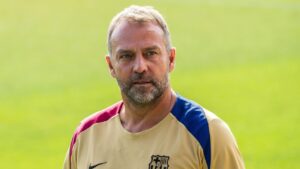CHICAGO — Last week provided the players on the U.S. women’s national team an opportunity to cleanse their psyches.
They played two friendlies against South Africa in which the USWNT won by a combined score of 5-0. Some new players like Chelsea forward Mia Fishel and Angel City defender M.A. Vignola made their international debuts. It was also a chance to celebrate the stellar careers of two retiring players in Julie Ertz and Megan Rapinoe.
Yet the disappointing performances at the 2023 Women’s World Cup are ones that don’t easily wash away. The USWNT’s round-of-16 exit at the World Cup was the earliest in the program’s history. The overall level of play was below the team’s usual standard, leading to the conclusion that teams around the world haven’t just caught up to the U.S., but in some ways — especially on the technical side — have surpassed it.
So over the past seven weeks, the U.S. players took their first collective steps in terms of moving beyond the World Cup. In exclusive interviews with ESPN, players say it hasn’t been easy.
“Very up and down. I think it was really hard for me,” Lindsey Horan, the USWNT’s new captain since the World Cup, told ESPN. “It was a different role that I had this World Cup, so I think I took it a little harder, and it was just coming back to the U.S., taking everything in, reflecting. It’s hard. It’s really difficult.”
– Stream on ESPN+: LaLiga, Bundesliga & more (U.S.)
The approach that players took in processing what happened varied. Some players dove right back into playing with their clubs; others took a brief period away to spend time with loved ones. But at a certain point, the game started to call them back. Returning to the U.S. national team fold is part of the recovery process, too — and with the 2024 Summer Olympics in Paris just 10 months away, there isn’t much time for players to hang their heads.
“I just think that in order to move on, you have to physically get back out there,” said USWNT and Washington Spirit midfielder Andi Sullivan prior to Sunday’s game against South Africa. “The sport has the ability to crush your heart, and it’s not like you wait until your heart is fully healed to get back out there because the only way to move on is to move on. So I think it was good to get back in with the Spirit, and it’s great to get back in here.”
The past seven weeks away from the national team also allowed the players time for introspection.
Some of it is obvious. Injuries to the likes of defender Becky Sauerbrunn and Mallory Swanson cut deep, forcing a shuffling of the lineup that left the team playing at a lower level than it had been. Finishing was also clearly an issue, with the U.S. underperforming its xG on average by more than a goal per 90 minutes of actual playing time (0.80 vs. 1.84). The play of the midfield was all over the place, dominating the likes of Vietnam and Sweden, but struggling against the Netherlands and Portugal. Breaking down a bunkered-in defense was an issue regardless of the opponent.
Meanwhile, other aspects were more subtle, with the U.S. often looking like it was feeling the pressure of the moment. Some routine passes from U.S. players went straight out of bounds. The team’s collective touch was just off at times.
There’s also the reality that in the World Cups the U.S. won in 2015 and 2019, an awful lot went right on the way to hoisting the trophy. In 2015, it wasn’t until the knockout stages — when suspensions resulted in Carli Lloyd being moved further forward as a support striker — that the U.S. hit its stride. In 2019, the U.S. rode out difficult periods thanks to players coming up in big moments, like goalkeeper Alyssa Naeher saving a penalty in the semifinal against England, or Rapinoe scoring goals at critical times on her way to winning the Golden Boot.
“I think in a World Cup, you need not just one thing to go our way,” USWNT defender Crystal Dunn told ESPN. “We need a bunch of things to go our way, whether that’s team form, whether that’s tactics, whether that’s just overall execution. I think we just didn’t hit the mark on a lot of those pieces at times, and unfortunately in a World Cup, I think you need all of those pieces.
“It’s not just one thing. It’s not just relying on one player to do amazing things. It’s the team collectively being able to be efficient and score goals. I think we just struggled a little bit to create the best goal-scoring opportunity, and that’s everybody. That’s not just forwards, that’s just the team as a whole.”
The showing at the World Cup ultimately cost manager Vlatko Andonovski his job. His assistant, Twila Kilgore, has stepped in to manage on an interim basis. That has created some uncertainty, but it’s also an opportunity to ask hard questions and implement changes to how the team plays.
So what would the players like to see in a new manager? “Someone who is up for the challenge,” said Sullivan, noting that the environment and expectations surrounding the USWNT are ridiculously high. Sullivan told ESPN with a laugh, “I’m glad that’s not my job” to decide who should take over, but there was near universal agreement that whoever comes next needs to move the program forward in terms of its capabilities, especially in attack.
“I think we want a coach that comes in and helps us in our style of play and sets a clear message of what we’re going to do moving forward and how we’re going to play moving forward,” Horan said. “But someone who also can get the best out of this team and can help in individual development, and just help this country grow in a way that we probably haven’t seen in women’s football in this country because a lot of teams are getting better and playing better and causing problems for us.”
That doesn’t mean the U.S. should completely rethink its approach; there’s plenty it does well. Defensively, the U.S. was rock-solid at the World Cup, conceding just once in four games. Centerback Naomi Girma looks set to lead the backline for the next decade.
The U.S. team is still very capable in transition given the dynamism of Trinity Rodman and Sophia Smith. That ability will be augmented when Swanson and Catarina Macario return from injury. Horan lauded “the way that we can absolutely kill teams on winning the ball back right away.”
“I just think in possession we can be more creative,” Horan added. “We can be better, we can have more ideas, and we can be more brave and confident like the Spain teams that we saw in the World Cup.”
Much of what Horan said in terms of the team’s weaknesses and what she wants in a new manager lines up with the thinking of U.S. Soccer sporting director Matt Crocker. During a roundtable with reporters before the USWNT faced South Africa, Crocker said he had spoken with about half of the team that was at the World Cup, and he hopes to talk to every one of them.
“I think there was definitely a sense that we need to be better with the ball and have more solutions, in particular in the building, what we call building the attack,” Crocker said. “It’s that sort of second phase, where once the ball goes to fullback or center back, how do we get it? How do we find solutions in midfield to retain possession and build and create?
“And then obviously there was a lot of reference to when we face a low block, we’ve got the ball and there’s a back five and a deep-four midfield, having solutions, creative solutions in those tight spaces and having the players and also the tactics to beat the low block really, and us needing to be better in that space.”
U.S. Soccer is about halfway through the search for its new USWNT manager, according to the federation, with the aim of finding someone who can implement a possession style, has a history of winning and is committed to player development. The process started by using data to compile a list of several hundred candidates, followed by a technical assessment that whittled the field to just over 10.
U.S. Soccer is currently evaluating the “human skills” of the remaining candidates, which looks at whether a candidate is a cultural fit and can communicate well with players and staff. Once that phase is complete, the list will be reduced even further. At that stage, U.S. Soccer will bring in finalists for a full day of evaluation.
This is similar to the process that on the men’s side led to the rehiring of Gregg Berhalter, a journey that involved psychometrics, abstract reasoning tasks, technical tasks and leadership tasks. Whichever candidate comes on top will be the one U.S. Soccer will try to hire, hopefully prior to the FIFA international window that runs from Nov. 27 to Dec. 6. At that point, the plan of the new manager will be presented to the team to allow for feedback.
Crocker cautioned that the emphasis on possession will take time to implement, as well as determination to stick with the plan.
“If we are going to be brave to play in tight pockets of space in those midfield areas to start with, we’re going to make mistakes,” he said. “And if the first time we make those mistakes, we just revert back to type, we’re never going to get past that stage. So we’ve got to be brave enough to know that on occasions things might go wrong.”
Horan, for one, said she is satisfied with the way Crocker is going about the search. She declined to get into the specifics of her conversations with him but told ESPN he’s asking the right questions of the players and staff, as well as how to progress the program.
“Maybe we’ve fallen off a little bit, in terms of everything, and we’ve got to get better,” she said. “I think [Crocker is] doing a really good job of just finding what works, what doesn’t. We’ve got to move forward.”




